Xyntha
Wyeth BioPharma Division of Wyeth Pharmaceuticals Inc., a subsidiary of Pfizer Inc.
HIGHLIGHTS OF PRESCRIBING INFORMATIONThese highlights do not include all the information needed to use XYNTHA safely and effectively. See full prescribing information for XYNTHA. XYNTHA SOLOFUSE™ [Antihemophilic Factor (Recombinant), Plasma/Albumin-Free]For Intravenous Injection - Lyophilized Powder for Solution in Prefilled Dual-Chamber Syringe Initial U.S. Approval: 2008INDICATIONS AND USAGEXYNTHA is a recombinant antihemophilic factor indicated for: Control and prevention of bleeding episodes in patients with hemophilia A (1.1) Surgical prophylaxis in patients with hemophilia A (1.2) XYNTHA is not indicated in patients with von Willebrand's disease.DOSAGE AND ADMINISTRATION For intravenous use after reconstitution only (2) The required dosage is determined using the following formula:Required units = body weight (kg) × desired factor VIII rise (IU/dL or % of normal) × 0.5 (IU/kg per IU/dL) where IU = International Unit Frequency of intravenous injection of the reconstituted product is determined by the type of bleeding episode and the recommendation of the treating physician. (2.1, 2.2) DOSAGE FORMS AND STRENGTHSXYNTHA SOLOFUSE is available as lyophilized powder in single-use prefilled dual-chamber syringes of: 250, 500, 1000, 2000 or 3000 IU. (3)CONTRAINDICATIONSDo not use in patients who have manifested life-threatening immediate hypersensitivity reactions, including anaphylaxis, to the product or its components, including hamster proteins.WARNINGS AND PRECAUTIONS Anaphylaxis and severe hypersensitivity reactions are possible. Patients may develop hypersensitivity to hamster protein, which is present in trace amounts in XYNTHA. Should such reactions occur, discontinue treatment with the product, and administer appropriate treatment. (5.1) Development of activity-neutralizing antibodies has been detected in patients receiving factor VIII-containing products, including XYNTHA. If expected plasma factor VIII activity levels are not attained, or if bleeding is not controlled with an appropriate dose, perform an assay that measures factor VIII inhibitor concentration. (5.2, 5.3, 6.2) Side EffectsThe most common adverse reactions (≥ 5%) with XYNTHA were headache, pyrexia, nausea, vomiting, diarrhea, and asthenia.Two patients (n=89), previously treated with factor VIII, developed inhibitors during the safety and efficacy clinical study. (6.2) In the surgery study (n=30), one low titer persistent inhibitor and one transient false-positive inhibitor were reported. (6.2) To report SUSPECTED ADVERSE REACTIONS, contact Wyeth Pharmaceuticals Inc. at 1-800-438-1985 or FDA at 1-800-FDA-1088 or www.fda.gov/medwatch USE IN SPECIFIC POPULATIONSPregnancy: No human or animal data. Use only if clearly needed. (8.1)
FULL PRESCRIBING INFORMATION: CONTENTS*
- 1 XYNTHA INDICATIONS AND USAGE
- 2 XYNTHA DOSAGE AND ADMINISTRATION
- 3 DOSAGE FORMS AND STRENGTHS
- 4 XYNTHA CONTRAINDICATIONS
- 5 WARNINGS AND PRECAUTIONS
- 6 XYNTHA ADVERSE REACTIONS
- 7 DRUG INTERACTIONS
- 8 USE IN SPECIFIC POPULATIONS
- 11 XYNTHA DESCRIPTION
- 12 CLINICAL PHARMACOLOGY
- 13 NONCLINICAL TOXICOLOGY
- 14 CLINICAL STUDIES
- 15 REFERENCES
- 16 HOW SUPPLIED/STORAGE AND HANDLING
- 17 PATIENT COUNSELING INFORMATION
- PRINCIPAL DISPLAY PANEL - 1000 IU Range Dual-Chamber Syringe Label
- PRINCIPAL DISPLAY PANEL - 1000 IU Range Tray Label
- PRINCIPAL DISPLAY PANEL - 1000 IU Range Kit Carton
- PRINCIPAL DISPLAY PANEL - 250 IU Range Dual-Chamber Syringe Label
- PRINCIPAL DISPLAY PANEL - 250 IU Range Tray Label
- PRINCIPAL DISPLAY PANEL - 250 IU Range Kit Carton
- PRINCIPAL DISPLAY PANEL - 500 IU Range Dual-Chamber Syringe Label
- PRINCIPAL DISPLAY PANEL - 500 IU Range Tray Label
- PRINCIPAL DISPLAY PANEL - 500 IU Range Kit Carton
- PRINCIPAL DISPLAY PANEL - 2000 IU Range Dual-Chamber Syringe Label
- PRINCIPAL DISPLAY PANEL - 2000 IU Range Tray Label
- PRINCIPAL DISPLAY PANEL - 2000 IU Range Kit Carton
- PRINCIPAL DISPLAY PANEL - 3000 IU Range Dual-Chamber Syringe Label
- PRINCIPAL DISPLAY PANEL - 3000 IU Range Tray Label
- PRINCIPAL DISPLAY PANEL - 3000 IU Range Kit Carton
FULL PRESCRIBING INFORMATION
1 INDICATIONS AND USAGE
1.1 Control and Prevention of Bleeding Episodes in Hemophilia A
XYNTHA, Antihemophilic Factor (Recombinant), Plasma/Albumin-Free is indicated for the control and prevention of bleeding episodes in patients with hemophilia A (congenital factor VIII deficiency or classic hemophilia).
1.2 Surgical Prophylaxis in Patients with Hemophilia A
XYNTHA, Antihemophilic Factor (Recombinant), Plasma/Albumin-Free is indicated for surgical prophylaxis in patients with hemophilia A.
XYNTHA does not contain von Willebrand factor, and therefore is not indicated in patients with von Willebrand's disease.
2 DOSAGE AND ADMINISTRATION
For intravenous use after reconstitution.
- Initiate treatment with XYNTHA under the supervision of a physician experienced in the treatment of hemophilia A.
- Dosage and duration of treatment depend on the severity of the factor VIII deficiency, the location and extent of bleeding, and the patient's clinical condition. Titrate the administered doses to the patient's clinical response. Careful control of replacement therapy is especially important in cases of major surgery or life-threatening bleeding episodes.
- One International Unit (IU) of factor VIII activity corresponds approximately to the quantity of factor VIII in one milliliter of normal human plasma. The calculation of the required dosage of factor VIII is based upon the empirical finding that, on average, 1 IU of factor VIII per kg body weight raises the plasma factor VIII activity by approximately 2 IU/dL.2 The required dosage is determined using the following formula:
The expected in vivo peak increase in factor VIII level expressed as IU/dL (or % normal) can be estimated using the following formulas:
Dosage (units) = body weight (kg) × desired factor VIII rise (IU/dL or % of normal) × 0.5 (IU/kg per IU/dL)
or
IU/dL (or % normal) = Total Dose (IU)/body weight (kg) × 2 [IU/dL]/[IU/kg]
The labeled potency of XYNTHA is based on the European Pharmacopoeia chromogenic substrate assay, in which the Wyeth manufacturing standard has been calibrated using a one-stage clotting assay. This method of potency assignment is intended to harmonize XYNTHA with clinical monitoring using a one-stage clotting assay [see Clinical Pharmacology (12.3) ].
2.1 Control and Prevention of Bleeding Episodes
In the case of the following bleeding events, consideration should be given to maintaining the factor VIII activity at or above the plasma levels (in % of normal or in IU/dL) outlined below for the indicated period.
The following chart can be used to guide dosing in bleeding episodes:
| Type of Bleeding Episode | Factor VIII Level Required (IU/dL or % of normal) | Frequency of Doses / Duration of Therapy |
|---|---|---|
| Minor | ||
| Early hemarthrosis, minor muscle or oral bleeds. | 20–40 | Repeat every 12–24 hours as necessary until resolved. At least 1 day, depending upon the severity of the bleeding episode. |
| Moderate | ||
| Bleeding into muscles. Mild head trauma. Bleeding into the oral cavity. |
30–60 | Repeat infusion every 12–24 hours for 3–4 days or until adequate local hemostasis is achieved. |
| Major | ||
| Gastrointestinal bleeding. Intracranial, intra-abdominal or intrathoracic bleeding. Fractures. |
60–100 | Repeat infusion every 8–24 hours until bleeding is resolved. |
2.2 Surgical Prophylaxis in Patients with Hemophilia A
In the case of the following bleeding events, consideration should be given to maintaining the factor VIII activity at or above the plasma levels (in % of normal or in IU/dL) outlined below for the indicated period. Monitoring of replacement therapy by means of plasma factor VIII activity is recommended, particularly for surgical intervention.
The following chart can be used to guide dosing in surgery:
| Type of Surgery | Factor VIII Level Required (IU/dL or % of normal) |
Frequency of Doses / Duration of Therapy |
|---|---|---|
| Minor | ||
| Minor operations, including tooth extraction. | 30–60 | Repeat infusion every 12–24 hours for 3–4 days or until adequate local hemostasis is achieved. For tooth extraction, a single infusion plus oral antifibrinolytic therapy within 1 hour may be sufficient. |
| Major | ||
| Major operations. | 60–100 | Repeat infusion every 8–24 hours until threat is resolved, or in the case of surgery, until adequate local hemostasis and wound healing are achieved. |
2.3 Instructions for Use
Administer XYNTHA by intravenous infusion after reconstitution of the lyophilized powder with the diluent (0.9% Sodium Chloride). In XYNTHA ® SOLOFUSE™, both the XYNTHA powder and the diluent are supplied within the prefilled dual-chamber syringe.
Patients should follow the specific reconstitution and administration procedures provided by their physician. Instructions are provided in the FDA-approved patient labeling [see Patient Counseling Information (17)]. The procedures below are general guidelines for the preparation, reconstitution and administration of XYNTHA.
For additional instructions on the use of a XYNTHA SOLOFUSE and a XYNTHA vial or the use of multiple XYNTHA SOLOFUSE, see Use of a XYNTHA Vial Kit and a XYNTHA SOLOFUSE Kit and Use of Multiple XYNTHA SOLOFUSE Kits sections below. [See Dosage and Administration (2.6) and (2.7) ]
2.4 Preparation and Reconstitution
Preparation
- Always wash hands before performing the following procedures.
- Use aseptic technique during the reconstitution procedures.
- Use all components for the reconstitution and administration of this product as soon as possible after opening their sterile containers to minimize unnecessary exposure to the atmosphere.
Note:
-
- If the patient uses one vial of XYNTHA with one XYNTHA SOLOFUSE for the infusion, reconstitute the vial and the syringe according to the instructions for that respective product kit. Use a separate 10 milliliter or larger luer lock syringe (not included in this kit) to draw back the reconstituted contents of the vial and the syringe. [See Dosage and Administration (2.6)]
- If the patient uses multiple XYNTHA SOLOFUSE syringes for the infusion, reconstitute each syringe according to the instructions below. Use a separate 10 milliliter or larger luer lock syringe (not included in this kit) to draw back the reconstituted contents of each syringe. [See Dosage and Administration (2.7)]
Reconstitution
- Allow the XYNTHA SOLOFUSE Kit to reach room temperature.
- Remove the contents of the XYNTHA SOLOFUSE Kit and place on a clean surface, making sure you have all the supplies you will need.
- Grasp the plunger rod as shown in the following diagram. Avoid contact with the shaft of the plunger rod. Screw the plunger rod firmly into the opening in the finger rest of the XYNTHA SOLOFUSE by pushing and turning firmly until resistance is felt (approximately 2 turns).
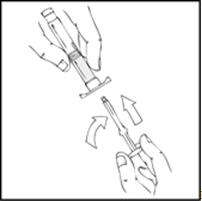
Note: Once the white tamper-evident seal is removed it is important to keep the XYNTHA SOLOFUSE in the upright position throughout the reconstitution process to prevent possible leakage.
-
4. Holding the XYNTHA SOLOFUSE upright, remove the white tamper-evident seal by bending the seal right to left (or a gentle rocking motion) to break the perforation of the cap and expose the grey rubber tip cap of the XYNTHA SOLOFUSE.
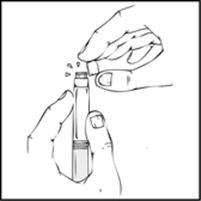
-
5. Remove the protective blue vented sterile cap from its package. While holding the XYNTHA SOLOFUSE upright, remove the grey rubber tip cap and replace it with the protective blue vented cap (prevents pressure build-up). Avoid touching the open end of both the syringe and the protective blue vented cap.
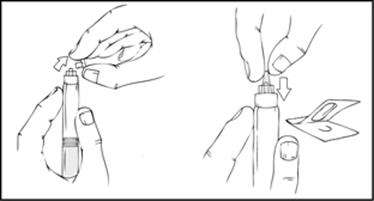
-
6. Gently and slowly advance the plunger rod by pushing until the two stoppers inside the XYNTHA SOLOFUSE meet, and all of the diluent is transferred to the chamber containing the XYNTHA powder.
Note: To prevent the escape of fluid from the tip of the syringe, the plunger rod should not be pushed with excessive force.
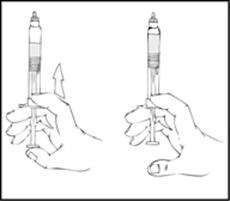
-
7. With the XYNTHA SOLOFUSE remaining upright, swirl gently several times until the powder is dissolved.
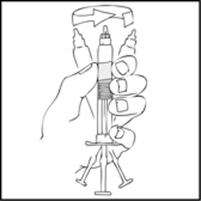
Note: The final solution should be inspected visually for particulate matter before administration. The solution should be clear to slightly opalescent and colorless. If it is not, discard the solution and use a new kit.
-
8. Holding the XYNTHA SOLOFUSE in an upright position, slowly advance the plunger rod until most, but not all, of the air is removed from the drug product chamber.

Note:
- If the solution is not to be used immediately, store the syringe upright, leaving the protective blue vent cap on the XYNTHA SOLOFUSE until ready to infuse.
- Store the reconstituted solution at room temperature prior to administration, but use within 3 hours after reconstitution or after removal of the grey rubber tip cap.
- XYNTHA, when reconstituted, contains polysorbate 80, which is known to increase the rate of di-(2-ethylhexyl)phthalate (DEHP) extraction from polyvinyl chloride (PVC). This should be considered during the preparation and administration of XYNTHA, including storage time elapsed in a PVC container following reconstitution. The tubing of the infusion set included with this kit does not contain DEHP.
2.5 Administration
Administer XYNTHA by intravenous infusion after reconstitution only.
Inspect the final XYNTHA solution visually for particulate matter and discoloration prior to administration. The solution should be clear to slightly opalescent and colorless. If it is not, discard the solution and use a new kit.
Administer XYNTHA solution using the infusion set included in the kit. Do not administer reconstituted XYNTHA in the same tubing or container with other medicinal products.
- After removing the protective blue vented cap, firmly attach the intravenous infusion set provided in the kit onto the XYNTHA SOLOFUSE.

-
2. Apply a tourniquet and prepare the injection site by wiping the skin well with an alcohol swab provided in the kit. -
3. Remove the protective needle cover and perform venipuncture. Insert the needle on the infusion set tubing into the vein, and remove the tourniquet. Verify proper needle placement. -
4. Inject the reconstituted XYNTHA intravenously over several minutes. The rate of administration should be determined by the patient's comfort level.
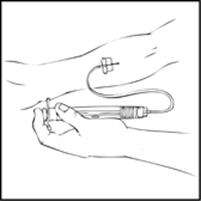
-
5. After infusing XYNTHA, remove and discard the infusion set. The amount of drug product left in the infusion set will not affect treatment.
Note: Dispose of all unused solution, the empty XYNTHA SOLOFUSE, and other used medical supplies in an appropriate container.
2.6 Use of a XYNTHA Vial Kit with a XYNTHA SOLOFUSE Kit
These instructions are for the use of only one XYNTHA vial kit with one XYNTHA SOLOFUSE Kit. For further information, please contact the Medical Information Department at Wyeth Pharmaceuticals, 1-800-438-1985.
- Reconstitute the XYNTHA vial using the instructions included with the product kit.
- Detach the empty diluent syringe from the vial adapter by gently turning and pulling the syringe counterclockwise, leaving the contents in the vial and the vial adapter in place.
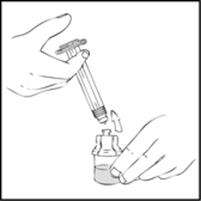
-
3. Reconstitute the XYNTHA SOLOFUSE using the instructions described in Preparation and Reconstitution [see Dosage and Administration (2.4)]. Remember to remove most, but not all, of the air from the drug product chamber.
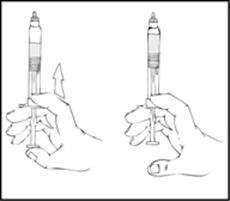
-
4. After removing the protective blue vented cap, connect the XYNTHA SOLOFUSE to the vial adapter by inserting the tip into the adapter opening while firmly pushing and turning the syringe clockwise until secured.
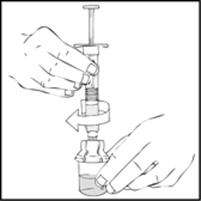
-
5. Slowly depress the plunger rod of the XYNTHA SOLOFUSE until the contents empty into the XYNTHA vial. The plunger rod may move back slightly after release.
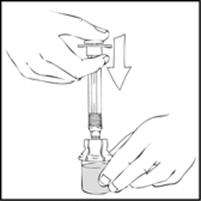
-
6. Detach and discard the empty XYNTHA SOLOFUSE from the vial adapter.
Note: If the syringe turns without detaching from the vial adapter, grasp the white collar and turn.
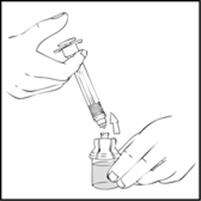
-
7. Connect a sterile 10 milliliter or larger luer lock syringe to the vial adapter. Inject some air into the vial to make withdrawing the vial contents easier.
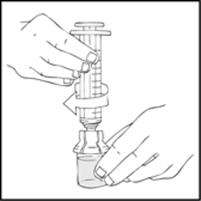
-
8. Invert the vial and slowly draw the solution into the large luer lock syringe.
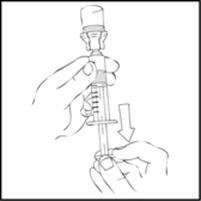
-
9. Detach the syringe from the vial adapter by gently turning and pulling the syringe counterclockwise. Discard the empty XYNTHA vial with the adapter attached. -
10. Attach the infusion set to the large luer lock syringe as directed [see Dosage and Administration (2.5) ].
2.7 Use of Multiple XYNTHA SOLOFUSE Kits
The instructions below are for the use of multiple XYNTHA SOLOFUSE kits with a 10 milliliter or larger luer lock syringe. For further information, please contact the Medical Information Department at Wyeth Pharmaceuticals, 1-800-438-1985.
Note: Luer-to-luer syringe connectors are not provided in these kits. Instruct patients to contact their XYNTHA supplier to order.
- Reconstitute all XYNTHA SOLOFUSE according to instructions described in Preparation and Reconstitution [see Dosage and Administration (2.4) ].
- Holding the XYNTHA SOLOFUSE in an upright position, slowly advance the plunger rod until most, but not all, of the air is removed from the drug product chamber.
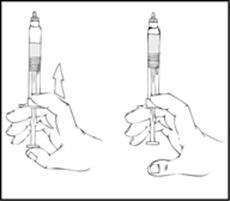
-
3. Remove the luer-to-luer syringe connector from its package. -
4. After removing the protective blue vented cap, connect a sterile 10 milliliter or larger luer lock syringe to one opening (port) in the syringe connector and the XYNTHA SOLOFUSE to the remaining open port on the opposite end.
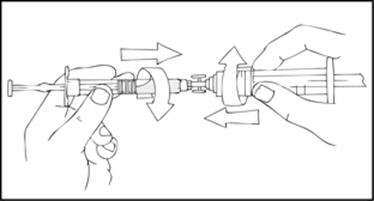
-
5. With the XYNTHA SOLOFUSE on top, slowly depress the plunger rod until the contents empty into the large luer lock syringe.

-
6. Remove the empty XYNTHA SOLOFUSE and repeat procedures 3 and 4 above for any additional reconstituted XYNTHA SOLOFUSE. -
7. Remove the luer-to-luer syringe connector from the large luer lock syringe and attach the infusion set as directed [see Dosage and Administration (2.5) ].
3 DOSAGE FORMS AND STRENGTHS
XYNTHA SOLOFUSE is available as a white to off-white lyophilized powder in the following nominal dosages:
- 250 International Units
- 500 International Units
- 1000 International Units
- 2000 International Units
- 3000 International Units
Each XYNTHA SOLOFUSE has the actual recombinant factor VIII (rFVIII) potency in International Units stated on the label.
4 CONTRAINDICATIONS
Do not use in patients who have manifested life-threatening immediate hypersensitivity reactions, including anaphylaxis, to the product or its components, including hamster proteins.
5 WARNINGS AND PRECAUTIONS
5.1 Anaphylaxis and Hypersensitivity Reactions
Allergic type hypersensitivity reactions are possible. Inform patients of the early signs or symptoms of hypersensitivity reactions (including hives [rash with itching], generalized urticaria, chest tightness, wheezing, and hypotension) and anaphylaxis. Advise patients to discontinue use of the product and to contact their physician if these symptoms occur. [See Patient Counseling Information (17) ]
XYNTHA contains trace amounts of hamster proteins. Patients treated with this product may develop hypersensitivity to these non-human mammalian proteins.
5.2 Neutralizing Antibodies
Patients using coagulation factor VIII products, including XYNTHA, should be monitored for the development of factor VIII inhibitors by appropriate clinical observations and laboratory tests. Inhibitors have been reported following administration of XYNTHA. If expected factor VIII activity plasma levels are not attained, or if bleeding is not controlled with an appropriate dose, an assay should be performed to determine if a factor VIII inhibitor is present [see Warnings and Precautions (5.3)].4,5,6,7,8,9,10,11,12
5.3 Monitoring Laboratory Tests
The clinical response to XYNTHA may vary. If bleeding is not controlled with the recommended dose, determine the plasma level of factor VIII and administer a sufficient dose of XYNTHA to achieve a satisfactory clinical response. If the patient's plasma factor VIII level fails to increase as expected or if bleeding is not controlled after the expected dose, suspect the presence of an inhibitor (neutralizing antibodies) [see Warnings and Precautions (5.2) ] and perform appropriate testing as follows.
- Use individual factor VIII values for recovery and, if clinically indicated, other pharmacokinetic characteristics to guide dosing and administration.
- Monitor plasma factor VIII activity levels by the one-stage clotting assay to confirm that adequate factor VIII levels have been achieved and are maintained, when clinically indicated [see Dosage and Administration (2) ].
- Monitor for development of factor VIII inhibitors. Perform assay to determine if factor VIII inhibitor is present when expected factor VIII activity plasma levels are not attained, or when bleeding is not controlled with the expected dose of XYNTHA. Use Bethesda Units (BU) to titer inhibitors.
6 ADVERSE REACTIONS
Overall, the most common adverse reactions (≥ 5%) with XYNTHA were headache, pyrexia, nausea, vomiting, diarrhea, and asthenia.
6.1 Clinical Trials Experience
Because clinical trials are conducted under widely varying conditions, adverse reaction rates observed in the clinical trials of a drug cannot be directly compared to rates in the clinical trials of another drug and may not reflect the rates observed in clinical practice.
XYNTHA was evaluated in two clinical studies (N=124). In the first study (n=94), safety and efficacy were examined in previously treated patients (PTPs) with hemophilia A (factor VIII activity in plasma [FVIII: C] ≤ 2%) who received XYNTHA for routine prophylaxis and on-demand treatment. Ninety-four patients received at least one dose of XYNTHA, resulting in a total of 6,775 infusions [see Clinical Studies (14) ]. The second study (n=30) examined the use of XYNTHA for surgical prophylaxis in previously treated patients with severe or moderately severe hemophilia A ([FVIII: C] ≤ 2%) who required elective major surgery and were expected to receive XYNTHA replacement therapy for at least 6 days post-surgery. All patients received at least one dose of XYNTHA, resulting in 1161 infusions. One patient received XYNTHA for a pre-surgery pharmacokinetic assessment only and did not undergo surgery [see Clinical Studies (14) ].
The most frequently reported adverse reaction in PTP patients was headache (24% of subjects). Other adverse reactions reported in ≥ 5% of patients were: nausea (6%), diarrhea (5%), asthenia (5%), and pyrexia (5%).
The most frequently reported adverse reaction in surgical patients was pyrexia (43%). Other adverse reactions reported in ≥ 5% of patients were: headache (13%), nausea (13%), and vomiting (7%).
6.2 Immunogenicity Information
There is a potential for immunogenicity with therapeutic proteins. The clinical studies for XYNTHA examined 94 patients who had previously been treated with factor VIII (PTPs) and 30 surgical patients. In the safety and efficacy study, two subjects with inhibitors were observed in 89 subjects (2.2%) who completed ≥ 50 exposure days. In a Bayesian statistical analysis, results from this study were used to update PTP results from a prior supporting study using XYNTHA manufactured at the initial facility (with one de novo and two recurrent inhibitors observed in 110 patients) and the experience with predecessor product (with one inhibitor observed in 113 subjects). The Bayesian analysis indicated that the population inhibitor rate for XYNTHA, an estimate of the 95% upper limit of the true inhibitor rate, was 4.17%.
None of the PTPs developed anti-CHO (Chinese hamster ovary) or anti-TN8.2 antibodies. One PTP developed anti-FVIII antibodies; but, this patient did not develop an inhibitor.
In the surgery study, one low titer persistent inhibitor and one transient false-positive inhibitor were reported. In this study, one surgical patient developed anti-CHO cell antibodies with no associated allergic reaction. One patient developed anti-FVIII antibodies; but, this patient did not develop an inhibitor.
Overall, no allergic manifestation to any immune response was observed during the study.
The detection of antibody formation is highly dependent on the sensitivity and specificity of the assay. Additionally, the observed incidence of antibody, including neutralizing antibody, positivity in an assay may be influenced by several factors, including assay methodology, sample handling, timing of sample collection, concomitant medications, and underlying disease. For these reasons, comparisons of the incidence of antibodies to XYNTHA with the incidence of antibodies to other products may be misleading.
6.3 Postmarketing Experience
Because these reactions are reported voluntarily from a population of uncertain size, it is not always possible to reliably estimate their frequency or establish a causal relationship to drug exposure.
The following postmarketing adverse reactions have been reported for XYNTHA:
Hypersensitivity Reactions
Anaphylaxis
Inhibitor Development
Inadequate therapeutic response
7 DRUG INTERACTIONS
None known.
8 USE IN SPECIFIC POPULATIONS
8.1 Pregnancy
Pregnancy Category C
Animal reproduction studies have not been conducted with XYNTHA. It is not known whether XYNTHA can cause fetal harm when administered to a pregnant woman or can affect reproduction capacity. XYNTHA should be given to a pregnant woman only if clinically indicated.
8.2 Labor and Delivery
There is no information available on the effect of factor VIII replacement therapy on labor and delivery. XYNTHA should be used only if clinically indicated.
8.3 Nursing Mothers
It is not known whether this drug is excreted into human milk. Because many drugs are excreted into human milk, caution should be exercised if XYNTHA is administered to nursing mothers. XYNTHA should be given to nursing mothers only if clinically indicated.
8.4 Pediatric Use
Pharmacokinetics of XYNTHA was studied in 7 previously treated patients 12–16 years of age. Pharmacokinetic parameters in these patients were similar to those obtained for adults after a dose of 50 IU/kg. For these 7 patients, the mean (± SD) Cmax and AUC∞ were 1.09 ± 0.21 IU/mL and 11.5 ± 5.2 IU∙h/mL, respectively. The mean clearance and plasma half-life values were 5.23 ± 2.36 mL/h/kg and 8.03 ± 2.44 hours (range 3.52 – 10.6 hours), respectively. The mean K-value and in vivo recoveries were 2.18 ± 0.41 IU/dL per IU/kg and 112 ± 23%, respectively.
8.5 Geriatric Use
Clinical studies of XYNTHA did not include subjects aged 65 and over. In general, dose selection for an elderly patient should be individualized.
11 DESCRIPTION
The active ingredient in XYNTHA, Antihemophilic Factor (Recombinant), Plasma/Albumin-Free, is a recombinant antihemophilic factor (rAHF), also called coagulation factor VIII, which is produced by recombinant DNA technology. It is secreted by a genetically engineered Chinese hamster ovary (CHO) cell line. The cell line is grown in a chemically defined cell culture medium that contains recombinant insulin, but does not contain any materials derived from human or animal sources.
The rAHF in XYNTHA is a purified glycoprotein, with an approximate molecular mass of 170 kDa consisting of 1,438 amino acids, which does not contain the B-domain.13 The amino acid sequence of the rAHF is comparable to the 90 + 80 kDa form of human coagulation factor VIII.
The purification process uses a series of chromatography steps, one of which is based on affinity chromatography using a patented synthetic peptide affinity ligand.14 The process also includes a solvent-detergent viral inactivation step and a virus-retaining nanofiltration step.
The potency expressed in International Units (IU) is determined using the chromogenic assay of the European Pharmacopoeia. The Wyeth manufacturing reference standard for potency has been calibrated against the World Health Organization (WHO) International Standard for factor VIII activity using the one-stage clotting assay. The specific activity of XYNTHA is 5,500 to 9,900 IU per milligram of protein.
XYNTHA is formulated as a sterile, nonpyrogenic, no preservative, lyophilized powder preparation for intravenous injection. Each single-use prefilled dual-chamber syringe (named XYNTHA SOLOFUSE) contains nominally 250, 500, 1000, 2000 or 3000 IU of XYNTHA. Upon reconstitution, the product is a clear to slightly opalescent, colorless solution that contains sodium chloride, sucrose, L-histidine, calcium chloride and polysorbate 80.
12 CLINICAL PHARMACOLOGY
12.1 Mechanism of Action
XYNTHA temporarily replaces the missing clotting factor VIII that is needed for effective hemostasis.
12.2 Pharmacodynamics
The activated partical thromboplastin time (aPTT) is prolonged in patients with hemophilia. Determination of aPTT is a conventional in vitro assay for biological activity of factor VIII. Treatment with XYNTHA normalizes the aPTT over the effective dosing period.
12.3 Pharmacokinetics
In a randomized crossover clinical study, 30 previously treated patients (PTP) 12–60 years old received a single infusion of 50 IU/kg of XYNTHA followed by a full-length recombinant FVIII (FLrFVIII) or a single infusion of FLrFVIII followed by XYNTHA. The one-stage clotting assay method was used to determine the concentrations of these two products in blood. XYNTHA was shown to be pharmacokinetically equivalent to FLrFVIII as the 90% confidence intervals for XYNTHA-to-FLrFVIII ratios of the mean values of Cmax and AUC∞ were within pre-established limits of 80% to 125%. The pharmacokinetic parameters of XYNTHA in these patients are summarized in Table 1.
In addition, 25 of the same patients later received a single infusion of 50 IU/kg of XYNTHA for a 6-month follow-up pharmacokinetic study. The parameters were comparable between baseline and 6 months, indicating no time-dependent changes in the pharmacokinetic properties of XYNTHA; the 90% confidence intervals for XYNTHA 6 month-to-baseline ratios of the mean values of Cmax and AUC∞ were within pre-established limits of 80% to 125%.
In a separate study investigating the efficacy of XYNTHA in patients with hemophilia A undergoing elective major surgery, 8 of 30 patients (≥ 12 years) who received a single 50 IU/kg infusion of XYNTHA as part of their presurgery evaluation participated in a pharmacokinetic evaluation. The pharmacokinetic parameters in these patients also are summarized in Table 1.
| Parameter | Initial Visit (n = 30) |
Month 6 (n = 25) | Pre-surgery (n=8) |
|---|---|---|---|
| Abbreviations: AUC∞ = area under the plasma concentration-time curve from zero to infinity; Cmax = peak concentration; K-value = incremental recovery; t1/2 = plasma elimination half-life; CL = clearance; n = number of subjects; SD = standard deviation. | |||
| Cmax (IU/mL) | 1.08 ± 0.22 | 1.24 ± 0.42 | 1.08 ± 0.24 |
| AUC∞ (IU∙hr/mL) | 13.5 ± 5.6 | 15.0 ± 7.5 | 16.0 ± 5.2 |
| t1/2 (hr) | 11.2 ± 5.0 | 11.8 ± 6.2 |
16.7 ± 5.4 |
| CL (mL/hr/kg) | 4.51 ± 2.23 | 4.04 ± 1.87 | 3.48 ± 1.25 |
| Vss (mL/kg) | 66.1 ± 33.0 | 67.4 ± 32.6 | 69.0 ± 20.1 |
| K-value (IU/dL per IU/kg) |
2.15 ± 0.44 | 2.47 ± 0.84 | 2.17 ± 0.47 |
| In vivo Recovery (%) | 103 ± 21 | 116 ± 40 | 104 ± 22 |
13 NONCLINICAL TOXICOLOGY
13.1 Carcinogenesis, Mutagenesis, Impairment of Fertility
No studies have been conducted with XYNTHA to assess its mutagenic or carcinogenic potential. XYNTHA has been shown to be comparable to the predecessor product with respect to its biochemical and physicochemical properties, as well as its nonclinical in vivo pharmacology and toxicology. By inference, predecessor product and XYNTHA would be expected to have equivalent mutagenic and carcinogenic potential. The predecessor product has been shown to be nongenotoxic in the mouse micronucleus assay. No studies have been conducted in animals to assess impairment of fertility or fetal development.
13.2 Animal Toxicology and/or Pharmacology
Preclinical studies evaluating XYNTHA in hemophilia A dogs without inhibitors demonstrated safe and effective restoration of hemostasis. XYNTHA demonstrated a toxicological profile that was similar to the toxicological profile observed with the predecessor product. Toxicity associated with XYNTHA was primarily associated with anti-FVIII neutralizing antibody generation first detectable at 15 days of repeat dosing in high (approximately 735 IU/kg/day) level-dosed, non-human primates.
14 CLINICAL STUDIES
Safety and Efficacy Study
In an open label safety and efficacy study (n=94), subjects received XYNTHA in a routine prophylaxis treatment regimen with on-demand treatment administered as clinically indicated. All 94 subjects were treated with at least one dose and all are included in the intent-to-treat (ITT) population. All subjects had been previously treated (previously treated patients or PTPs) with factor VIII. Eighty-nine (89) subjects accrued ≥ 50 exposure days. Median age for the 94 treated subjects was 24 years (mean 27.7 and range 12–60 years). All subjects had ≥ 150 previous exposure days with baseline FVIII activity level of ≤ 2%.
For routine prophylaxis, XYNTHA was administered at a dose of 30 ± 5 IU/kg 3 times a week with provisions for dose escalation based on pre-specified criteria. Seven dose escalations were prescribed for 6 subjects during the course of the study. Forty-three subjects (43/94 or 45.7%) reported no bleeding while on routine prophylaxis. The median annualized bleeding rate (ABR) for all bleeding episodes was 1.9 (mean 3.9, range 0–42.1).
Fifty-three subjects (53/94) received XYNTHA for on-demand treatment for a total of 187 bleeding episodes (Table 2). Seven of these bleeding episodes occurred in subjects prior to switching to a prophylaxis treatment regimen. One hundred ten of 180 bleeds (110/180 or 61.1%) occurred ≤ 48 hours after the last dose and 38.9% (70/180 bleeds) occurred > 48 hours after the last dose. The majority of bleeds reported to occur ≤ 48 hours after the last prophylaxis dose were traumatic (64/110 bleeds or 58.2%). Forty-two bleeds (42/70 or 60%) reported to occur > 48 hours after the last prophylaxis dose were spontaneous. The on-demand treatment dosing regimen was determined by the investigator. The median dose for on-demand treatment was 30.6 IU/kg (range, 6.4 to 74.4 IU/kg).
| ≤ 24 hrs | > 24 ≤ 48 hrs | > 48 ≤ 72 hrs | > 72 hrs | Unknown |
Total Bleeding Episodes | |||||
|---|---|---|---|---|---|---|---|---|---|---|
| Spon | Traum | Spon | Traum | Spon | Traum | Spon | Traum | Spon | Traum | |
| 13 | 20 | 33 | 44 | 24 | 12 | 18 | 16 | 3 | 4 | 187 |
The majority of bleeding episodes (173/187 or 92.5%) resolved with 1 or 2 infusions. Subjects rated the outcomes of infusions on a pre-specified four (4) point hemostatic efficacy scale. One hundred thirty-two of 187 bleeding episodes (132/187 or 70.6%) treated with XYNTHA were rated excellent or good in their response to initial treatment, 45 (24.1%) were rated moderate. Five (2.7%) were rated no response, and 5 (2.7%) were not rated.
| -------------------Number of Infusions (%)------------------- | ||||||
|---|---|---|---|---|---|---|
| Response to 1st Infusion |
1 | 2 | 3 | 4 | > 4 | Total Number of Bleeds |
| Excellent | 42 (95.5) | 2 (4.5) | 0 (0.0) | 0 (0.0) | 0 (0.0) | 44 |
| Good | 69 (78.4) | 16 (18.2) | 3 (3.4) | 0 (0.0) | 0 (0.0) | 88 |
| Moderate | 24 (53.3) | 16 (35.6) | 2 (4.4) | 0 (0.0) | 3 (6.7) | 45 |
| No Response | 0 (0.0) | 0 (0.0) | 2 (40.0) | 2 (40.0) | 1 (20.0) | 5 |
| Not Assessed | 4 (80.0) | 0 (0.0) | 0 (0.0) | 1 (20.0) | 0 (0.0) | 5 |
| Total | 139 (74.3) | 34 (18.2) | 7 (3.7) | 3 (1.6) | 4 (2.1) | 187 |
Of the 94 subjects enrolled in this study, 30 evaluable subjects participated in a randomized crossover pharmacokinetics study. Twenty-five (25/30) of these subjects with FVIII:C ≤ 1% completed both the first (PK1) and the second (PK2) pharmacokinetic assessments [see Clinical Pharmacology (12.3) ].
Surgical Prophylaxis Study
In an open-label study (n=30) for surgical prophylaxis in subjects with hemophilia A, XYNTHA was administered to 25 efficacy-evaluable PTPs with severe or moderately severe (FVIII:C ≤ 2%) hemophilia A undergoing major surgical procedures (11 total knee replacements, 1 hip replacement, 5 synovectomies, 1 left ulnar nerve transposition release, 1 ventral hernia repair/scar revision, 1 knee arthroscopy, 1 revision and debridement of the knee after a total knee replacement, 1 hip arthroplasty revision, 1 stapes replacement, 1 ankle arthrodesis, and 1 pseudotumor excision).
The results of the hemostatic efficacy ratings for these subjects are presented in Table 4. Investigator's ratings of efficacy at the end of surgery and at the end of the initial postoperative period were "excellent" or "good" for all assessments. Intraoperative blood loss was reported as "normal" or "absent" for all subjects. Thirteen of the subjects (13/25 or 52%) had blood loss in the postoperative period. The postoperative blood loss was rated as "normal" for ten of these cases while three cases were rated "abnormal" (1 due to hemorrhage following surgical trauma to the epigastric artery, 1 due to an 800 mL blood loss after hip replacement surgery, and 1 after an elbow synovectomy where the blood loss could not be measured by the investigator).
| Time of Hemostatic Efficacy Assessment | Excellent | Good | Number of subjects |
|---|---|---|---|
| End of surgery | 18 (72%) | 7 (28%) | 25 |
End of initial postoperative period |
23 (92%) | 2 (8%) | 25 |
15 REFERENCES
- Nilsson IM, Berntorp EE and Freiburghaus C. Treatment of patients with factor VIII and IX inhibitors. Thromb Haemost. 1993;70(1):56–59.
- Hoyer LW. Hemophilia A. N Engl J Med. 1994;330:38–47.
- Juhlin F. Stability and Compatibility of Reconstituted Recombinant Factor VIII SQ, 250 IU/ml, in a System for Continuous Infusion. Pharmacia Document 9610224, 1996.
- Ehrenforth S, Kreuz W, Scharrer I, et al. Incidence of development of factor VIII and factor IX inhibitors in hemophiliacs. Lancet. 1992;339:594–598.
- Lusher J, Arkin S, Abildgaard CF, Schwartz RS, the Kogenate PUP Study Group. Recombinant factor VIII for the treatment of previously untreated patients with hemophilia A. N Engl J Med. 1993;328:453–459.
- Bray GL, Gomperts ED, Courter S, et al. A multicenter study of recombinant factor VIII (Recombinate): safety, efficacy, and inhibitor risk in previously untreated patients with hemophilia A. Blood. 1994;83(9):2428–2435.
- Kessler C, Sachse K. Factor VIII:C inhibitor associated with monoclonal-antibody purified FVIII concentrate. Lancet. 1990;335:1403.
- Schwartz RS, Abildgaard CF, Aledort LM, et al. Human recombinant DNA-derived antihemophilic factor (factor VIII) in the treatment of hemophilia A. N Engl J Med. 1990;323:1800–1805.
- White GC II, Courter S, Bray GL, et al. A multicenter study of recombinant factor VIII (Recombinate™) in previously treated patients with hemophilia A. Thromb Haemost. 1997;77(4):660–667.
- Gruppo R, Chen H, Schroth P, et al. Safety and immunogenicity of recombinant factor VIII (Recombinate™) in previously untreated patients: A 7.3 year update. Haemophilia. 1998;4:228 (Abstract No. 291, XXIII Congress of the WFH, The Hague).
- Scharrer I, Bray GL, Neutzling O. Incidence of inhibitors in haemophilia A patients - a review of recent studies of recombinant and plasma-derived factor VIII concentrates. Haemophilia. 1999;5:145–154.
- Abshire TC, Brackmann HH, Scharrer I, et al. Sucrose formulated recombinant human antihemophilic Factor VIII is safe and efficacious for treatment of hemophilia A in home therapy: Results of a multicenter, international, clinical investigation. Thromb Haemost. 2000;83(6):811–816.
- Sandberg H, Almstedt A, Brandt J, Castro VM, Gray E, Holmquist L, et al. Structural and Functional Characterization of B-Domain Deleted Recombinant Factor VIII. Sem Hematol. 2001;38 (Suppl. 4):4–12.
- Kelley BD, Tannatt M, Magnusson R, Hagelberg S. Development and Validation of an Affinity Chromatography Step Using a Peptide Ligand for cGMP Production of Factor VIII. Biotechnol Bioeng. 2004;87(3):400–412.
- Mann KG and Ziedens KB. Overview of Hemostasis. In: Lee CA, Berntorp EE and Hoots WK, eds. Textbook of Hemophilia. USA, Blackwell Publishing; 2005:1–4.
16 HOW SUPPLIED/STORAGE AND HANDLING
16.1 How Supplied
XYNTHA SOLOFUSE is supplied in a kit that includes the XYNTHA lyophilized powder containing nominally 250, 500, 1000, 2000 or 3000 IU and 4 mL 0.9 % Sodium Chloride solution for reconstitution in a prefilled dual-chamber syringe:
250 International Units Kit: NDC 58394-022-03
500 International Units Kit: NDC 58394-023-03
1000 International Units Kit: NDC 58394-024-03
2000 International Units Kit: NDC 58394-025-03
3000 International Units Kit: NDC 58394-016-03
Each XYNTHA SOLOFUSE Kit contains: one plunger rod for assembly, one sterile infusion set, two alcohol swabs, one bandage, one gauze pad, one vented sterile cap, and one package insert.
Actual factor VIII activity in International Units is stated on the label of each XYNTHA SOLOFUSE.
16.2 Storage and Handling
Product as Packaged for Sale:
- Store XYNTHA SOLOFUSE under refrigeration at a temperature of 2° to 8°C (36° to 46°F) for up to 36 months from the date of manufacture until the expiration date stated on the label. Within the expiration date, XYNTHA SOLOFUSE also may be stored at room temperature not to exceed 25°C (77°F) for up to 3 months.
- Clearly record the starting date at room temperature storage in the space provided on the outer carton. At the end of the 3-month period, immediately use or discard the product. Do not put the product back into the refrigerator.
- Do not use XYNTHA SOLOFUSE after the expiration date stated on the label or after 3 months when stored at room temperature, whichever is earlier.
- Do not freeze. (Freezing may damage the XYNTHA SOLOFUSE.)
- During storage, avoid prolonged exposure of XYNTHA SOLOFUSE to light.
Product After Reconstitution:
- Store the reconstituted solution at room temperature prior to administration. Remember to administer XYNTHA SOLOFUSE within 3 hours after reconstitution or after removal of the grey rubber tip cap from the product.
17 PATIENT COUNSELING INFORMATION
See FDA-approved patient labeling (Patient Information and Instructions for Use)
Advise the patients of the following
- Tell their healthcare provider about any adverse reactions or problems that concern them when taking XYNTHA.
- Allergic-type hypersensitivity reactions are possible. Discuss the early signs of hypersensitivity reactions (including hives [rash with itching], generalized urticaria, tightness of the chest, wheezing, hypotension) and anaphylaxis. Advise patients to discontinue use of the product, call their healthcare provider, and go to the emergency department if these symptoms occur.
- Tell their healthcare provider if they experience a lack of a clinical response to factor VIII replacement therapy, as this may be a manifestation of an inhibitor.
- Tell their healthcare provider if they become pregnant or intend to become pregnant during therapy.
- Notify their healthcare provider if they are breastfeeding.
- Local irritation may occur when infusing XYNTHASOLOFUSE.
- Consult their healthcare provider prior to travel and to bring an adequate supply of XYNTHA SOLOFUSE, based on their current regimen, for anticipated treatment when traveling.
FDA-Approved Patient Labeling
Patient Information
XYNTHA® SOLOFUSE™ /ZIN-tha/
[Antihemophilic Factor (Recombinant), Plasma/Albumin-Free]
Please read this patient information carefully before using XYNTHA and each time you get a refill. There may be new information. This leaflet does not take the place of talking with your healthcare provider about your medical problems or your treatment.
What is XYNTHA?
XYNTHA is an injectable medicine that is used to help control and prevent bleeding in people with hemophilia A. Hemophilia A is also called classic hemophilia.
XYNTHA is not used to treat von Willebrand's disease.
What should I tell my healthcare provider before using XYNTHA?
Tell your healthcare provider about all of your medical conditions, including if you:
- are pregnant or planning to become pregnant. It is not known if XYNTHA may harm your unborn baby.
- are breastfeeding. It is not known if XYNTHA passes into your milk and if it can harm your baby.
Tell your healthcare provider about all of the medicines you take, including all prescription and non-prescription medicines, such as over-the-counter medicines, supplements, or herbal remedies.
How should I infuse XYNTHA?
Step-by-step instructions for infusing with XYNTHA SOLOFUSE are provided at the end of this leaflet.
The steps listed below are general guidelines for using XYNTHA SOLOFUSE. Always follow any specific instructions from your healthcare provider. If you are unsure of the procedures, please call your healthcare provider before using.
Call your healthcare provider right away if bleeding is not controlled after using XYNTHA.
Your body can make antibodies against XYNTHA (called "inhibitors") that may stop XYNTHA from working properly. Your healthcare provider may need to take blood tests from time to time to monitor for inhibitors.
Call your healthcare provider right away if you take more than the dose you should take.
Talk to your healthcare provider before traveling. Plan to bring enough XYNTHA SOLOFUSE for your treatment during this time.
What are the possible or reasonably likely side effects of XYNTHA?
Common side effects of XYNTHA are
- headache
- fever
- nausea
- vomiting
- diarrhea
- weakness
Call your healthcare provider or go to the emergency department right away if you have any of the following symptoms because these may be signs of a serious allergic reaction:
- wheezing
- difficulty breathing
- chest tightness
- turning blue (look at lips and gums)
- fast heartbeat
- swelling of the face
- faintness
- rash
- hives
Talk to your healthcare provider about any side effect that bothers you or that does not go away. You may report side effects to FDA at 1-800-FDA-1088.
How should I store XYNTHA SOLOFUSE?
Store in the refrigerator at 36° to 46°F (2° to 8°C).
Do not freeze.
Protect from light.
XYNTHA SOLOFUSE can last at room temperature (below 77°F) for up to 3 months. If you store XYNTHA SOLOFUSE at room temperature, carefully write down the date you put XYNTHA SOLOFUSE at room temperature, so you will know when to throw it away. There is a space on the carton for you to write the date.
Throw away any unused XYNTHA SOLOFUSE after the expiration date.
Infuse within 3 hours after reconstitution or after removal of the grey rubber tip cap from the prefilled dual-chamber syringe. You can keep the reconstituted solution at room temperature before infusion, but if it is not used in 3 hours, throw it away.
Do not use reconstituted XYNTHA if it is not clear to slightly opalescent and colorless.
Dispose of all materials, whether reconstituted or not, in an appropriate medical waste container.
What else should I know about XYNTHA?
Medicines are sometimes prescribed for purposes other than those listed here. Talk to your healthcare provider if you have any concerns. You can ask your healthcare provider for information about XYNTHA SOLOFUSE that was written for healthcare professionals.
Do not share XYNTHA SOLOFUSE with other people, even if they have the same symptoms that you have.
Instructions for Use
XYNTHA® SOLOFUSE™ /ZIN-tha/
[Antihemophilic Factor (Recombinant), Plasma/Albumin-Free]
XYNTHA SOLOFUSE is supplied as a pre-filled dual-chamber syringe with lyophilized XYNTHA powder in one chamber and 0.9% sodium chloride solution in the other chamber. Before you can infuse it (intravenous injection), you must reconstitute the powder by mixing it with the sodium chloride solution.
Reconstitute and infuse XYNTHA SOLOFUSE using the infusion set provided in this kit. Please follow the directions below for the proper use of this product.
PREPARATION AND RECONSTITUTION OF XYNTHA SOLOFUSE
Preparation
- Always wash your hands before doing the following steps.
- Keep everything clean and germ-free while you are reconstituting XYNTHA SOLOFUSE.
- Once the syringes are open, finish reconstituting XYNTHA SOLOFUSE as soon as possible. This will help to keep them germ-free.
- For additional instructions on the use of a XYNTHA SOLOFUSE and a XYNTHA vial or multiple XYNTHA SOLOFUSE, see the detailed information provided after INFUSION OF XYNTHA section.
Reconstitution
- Allow the XYNTHA SOLOFUSE to reach room temperature.
- Remove the contents of the XYNTHA SOLOFUSE Kit and place on a clean surface, making sure you have all the supplies you will need.
- Grasp the plunger rod as shown in the following diagram. Do not touch the shaft of the plunger rod. Screw the plunger rod firmly into the opening in the finger rest of the XYNTHA SOLOFUSE by pushing and turning firmly until resistance is felt (approximately 2 turns).
Throughout the reconstitution process, it is important to keep the XYNTHA SOLOFUSE upright to prevent possible leakage.

-
4. Holding the XYNTHA SOLOFUSE upright, remove the white tamper-evident seal by bending the seal right to left (or a gentle rocking motion) to break the perforation of the cap and expose the grey rubber tip cap of the XYNTHA SOLOFUSE.

-
5. Remove the protective blue vented sterile cap from its package. While holding the XYNTHA SOLOFUSE upright, remove the grey rubber tip cap and replace it with the protective blue vented cap (prevents pressure build-up). Avoid touching the open end of both the syringe and the protective blue vented cap.

-
6. Gently and slowly push the plunger rod until the two stoppers inside the XYNTHA SOLOFUSE meet, and all of the diluent is transferred to the chamber containing the XYNTHA powder.
Note: To prevent the escape of fluid from the tip of the syringe, do not push the plunger rod with excessive force.

-
7. With the XYNTHA SOLOFUSE remaining upright, swirl gently several times until the powder is dissolved.

-
-
8. Holding the XYNTHA SOLOFUSE in an upright position, slowly advance the plunger rod until most, but not all, of the air is removed from the drug product chamber.

Note:
- If you are not using the solution immediately, store the syringe upright and keep the protective blue vent cap on the XYNTHA SOLOFUSE until ready to infuse.
- Infuse XYNTHA solution within 3 hours after reconstitution or removal of the grey tip cap from the XYNTHA SOLOFUSE. The reconstituted solution may be kept at room temperature for up to 3 hours prior to infusion. If you have not used it in 3 hours, throw it away.
- If more than one XYNTHA SOLOFUSE is needed for each infusion, a luer-to-luer syringe connector can be used (not included in this kit). Please contact your doctor or healthcare provider, or call the Wyeth Medical Information Department at 1-800-438-1985, for additional information.
INFUSION OF XYNTHA
Your healthcare provider will teach you how to infuse XYNTHA yourself. Once you learn how to do this, you can follow the instructions in this insert.
Before XYNTHA can be infused, you must reconstitute it as instructed above in the PREPARATION AND RECONSTITUTION OF XYNTHA SOLOFUSE section.
After reconstitution, be sure to look carefully at the XYNTHA solution. The solution should be clear to slightly opalescent and colorless. If it is not, throw away the solution and use a new kit.
Use the infusion set included in the kit to infuse XYNTHA. Do not infuse XYNTHA in the same tubing or container with other medicines.
- After removing the protective blue vented cap, firmly attach the intravenous infusion set provided in the kit onto the XYNTHA SOLOFUSE.

-
2. Apply a tourniquet and prepare the injection site by wiping the skin well with an alcohol swab provided in the kit.
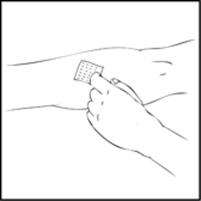
-
3. Remove the protective needle cover and insert the butterfly needle of the infusion set tubing into your vein as instructed by your healthcare provider. Remove the tourniquet. Verify proper needle placement. -
4. Infuse the reconstituted XYNTHA product over several minutes. Your comfort level should determine the rate of infusion.

-
5. After infusing XYNTHA, remove the infusion set and throw it away. The amount of liquid left in the infusion set will not affect your treatment.
Note:
- Throw away all unused solution, the empty XYNTHA SOLOFUSE, and other used medical supplies in an appropriate container.
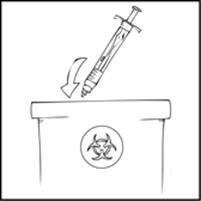
- It is a good idea to record the lot number from the XYNTHA SOLOFUSE label every time you use XYNTHA. You can use the peel-off label found on the XYNTHA SOLOFUSE to record the lot number.
ADDITIONAL INSTRUCTIONS
XYNTHA is also supplied in kits that include single-use vials with lyophilized powder and prefilled diluent syringes.
If you use one XYNTHA vial and one XYNTHA SOLOFUSE for the infusion, reconstitute the XYNTHA vial and the XYNTHA SOLOFUSE according to the specific directions for that respective product kit. Use a separate, 10 milliliter or larger luer lock syringe (not included in this kit) to draw back the reconstituted contents of the XYNTHA vial and the XYNTHA SOLOFUSE.
If you use multiple XYNTHA SOLOFUSE kits for the infusion, reconstitute each XYNTHA SOLOFUSE according to the directions above. Use a separate, 10 milliliter or larger luer lock syringe (not included in this kit) to draw back the reconstituted contents of any additional XYNTHA SOLOFUSE.
Use of a XYNTHA Vial Kit with a XYNTHA SOLOFUSE Kit
These instructions are for the use of only one XYNTHA vial kit with one XYNTHA SOLOFUSE Kit. For further information, please contact your healthcare provider or call the Medical Information Department at Wyeth Pharmaceuticals, 1-800-438-1985.
- Reconstitute the XYNTHA vial using the instructions included with the kit. Detach the empty diluent syringe from the vial adapter by gently turning and pulling the syringe counterclockwise, leaving the contents in the XYNTHA vial with the vial adapter in place.

-
2. Reconstitute the XYNTHA SOLOFUSE using the instructions included with the product kit, remembering to remove most, but not all, of the air from the syringe.

-
3. After removing the protective blue vented cap, connect the XYNTHA SOLOFUSE to the vial adapter by inserting the tip into the adapter opening while firmly pushing and turning the syringe clockwise until secured.

-
4. Slowly push the plunger rod of the XYNTHA SOLOFUSE to empty the contents into the XYNTHA vial. The plunger rod may move back slightly after release.

-
5. Detach the empty XYNTHA SOLOFUSE from the vial adapter and throw it away. If the syringe turns without detaching from the vial adapter, grasp the white collar and turn.

-
6. Connect a sterile 10 milliliter or larger luer lock syringe to the vial adapter. You may want to inject some air into the vial to make withdrawing the vial contents easier.

-
7. Invert the XYNTHA vial and slowly draw the solution into the large luer lock syringe.

-
8. Detach the large luer lock syringe from the vial adapter by gently turning and pulling the syringe counterclockwise. Throw away the empty XYNTHA vial with the adapter attached. -
9. Attach the infusion set to the large luer lock syringe as directed in the INFUSION OF XYNTHA section.
Note: Dispose of all unused solution, the empty XYNTHA SOLOFUSE, and other used medical supplies in an appropriate container.

Use of Multiple XYNTHA SOLOFUSE Kits
The instructions below are for the use of multiple XYNTHA SOLOFUSE kits with a 10 milliliter or larger luer lock syringe. For further information, please contact your healthcare provider or call the Medical Information Department at Wyeth Pharmaceuticals, 1-800-438-1985.
Note: Luer-to-luer syringe connectors are not provided in the kits. Contact your XYNTHA supplier to order.
- Reconstitute all XYNTHA SOLOFUSE according to instructions described in PREPARATION AND RECONSTITUTION OF XYNTHA SOLOFUSE section. Holding the XYNTHA SOLOFUSE in an upright position, slowly push the plunger rod until most, but not all, of the air is removed from the syringe.

-
2. Remove the luer-to-luer syringe connector from its package. -
3. After removing the protective blue vented cap, connect a sterile 10 milliliter or larger luer lock syringe to one opening (port) in the syringe connector and the XYNTHA SOLOFUSE to the remaining open port on the opposite end.

-
4. With the XYNTHA SOLOFUSE on top, slowly push the plunger rod to empty all the XYNTHA SOLOFUSE content into the large luer lock syringe.

-
5. Remove the empty XYNTHA SOLOFUSE and repeat procedures 3 and 4 above for any additional XYNTHA SOLOFUSE. -
6. Remove the luer-to-luer syringe connector from the large luer lock syringe and attach the infusion set as directed in the INFUSION OF XYNTHA section.
Note: Dispose of all unused solution, the empty XYNTHA SOLOFUSE, and other used medical supplies in an appropriate container.

License no: 3
LAB-0500-8.0
PRINCIPAL DISPLAY PANEL - 1000 IU Range Dual-Chamber Syringe Label
NDC 58394-124-03
Xyntha® Solofuse®
Rx only
Antihemophilic Factor
(Recombinant),
Plasma/Albumin-Free
For IV Administration
Dual-Chamber Syringe
No Preservatives. Single Use.
Refrigerate. Protect from light.
Wyeth Pharmaceuticals Inc.
Philadelphia, PA 19101
US Govt. License No. 3
1000 IU Range
For Factor VIII Replacement
XYNTHA
SOLOFUSE
Dual-Chamber
Syringe
PAA034214
Lot:
Exp.:
Pot.:
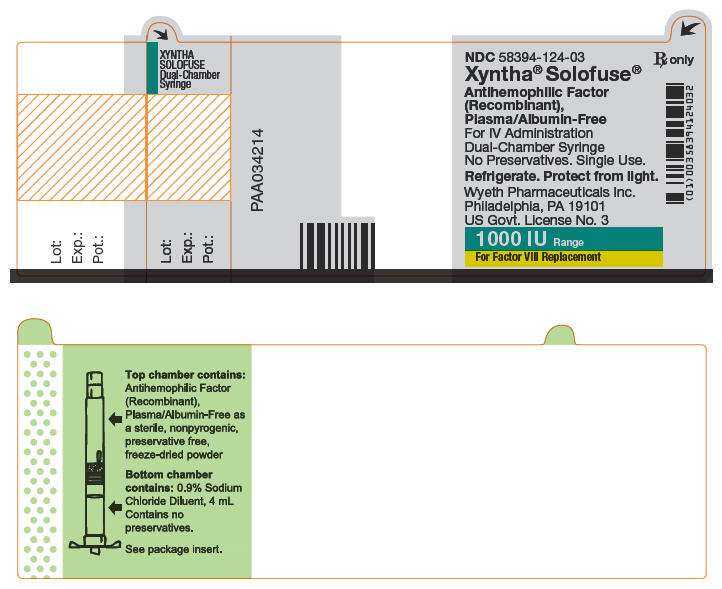
PRINCIPAL DISPLAY PANEL - 1000 IU Range Tray Label
xyntha® solofuse®
Antihemophilic Factor (Recombinant),
Plasma/Albumin-Free
1000 IU Range
For Factor VIII Replacement
Therapy Only
Manufactured by
Wyeth Pharmaceuticals Inc
A subsidiary of Pfizer Inc
Philadelphia, PA 19101
US Govt. License No. 3
PAA034219
NDC 58394-024-03
Single-Use, Dual-Chamber Syringe, Prefilled with
XYNTHA and Diluent
For Intravenous Administration.
Pfizer
Rx only
Plasma-Free Albumin-Free Cell Culture Process
Store in a refrigerator at 2° to 8°C (36° to 46°F).
XYNTHA may also be stored at room temperature not to exceed
25°C (77°F) for up to 3 months, until the expiration date. Do not
return product to refrigerated storage after room temperature
storage. During storage, avoid prolonged exposure of XYNTHA
SOLOFUSE syringe to light. Do not freeze as damage may result
to the prefilled dual-chamber syringe.
Lot:
Exp.:
Pot.: I.U.
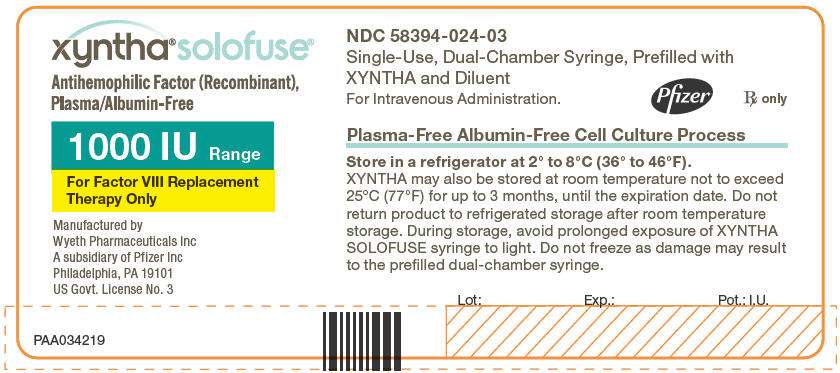
PRINCIPAL DISPLAY PANEL - 1000 IU Range Kit Carton
One Single-Use, Prefilled Dual-Chamber Syringe
NDC 58394-024-03
1000 IU Range
xyntha® solofuse®
Antihemophilic Factor (Recombinant),
Plasma/Albumin-Free
Single-Use,
Dual-Chamber
Syringe, Prefilled
with XYNTHA
and Diluent
Plasma-Free Albumin-Free Cell Culture Process
For Factor VIII Replacement
Therapy Only
For Intravenous Administration.
Rx only
Pfizer

PRINCIPAL DISPLAY PANEL - 250 IU Range Dual-Chamber Syringe Label
NDC 58394-122-03
Xyntha® Solofuse®
Rx only
Antihemophilic Factor
(Recombinant),
Plasma/Albumin-Free
For IV Administration
Dual-Chamber Syringe
No Preservatives. Single Use.
Refrigerate. Protect from light.
Wyeth Pharmaceuticals Inc.
Philadelphia, PA 19101
US Govt. License No. 3
250 IU Range
For Factor VIII Replacement
XYNTHA
SOLOFUSE
Dual-Chamber
Syringe
PAA034212
Lot:
Exp.:
Pot.:
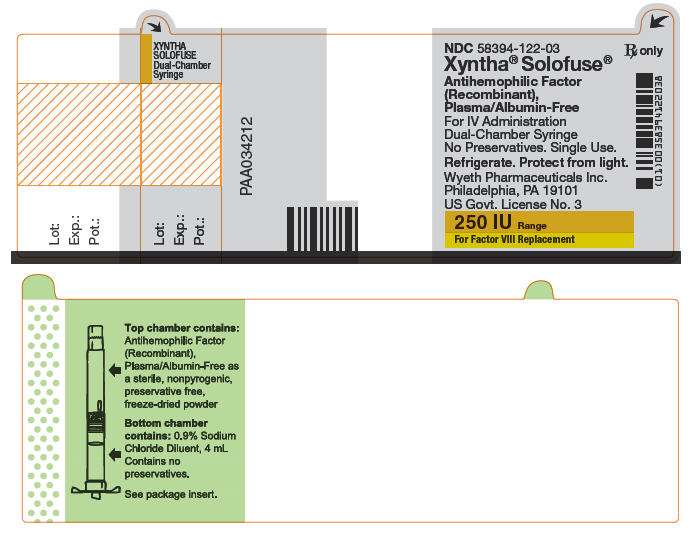
PRINCIPAL DISPLAY PANEL - 250 IU Range Tray Label
xyntha® solofuse®
Antihemophilic Factor (Recombinant),
Plasma/Albumin-Free
250 IU Range
For Factor VIII Replacement
Therapy Only
Manufactured by
Wyeth Pharmaceuticals Inc
A subsidiary of Pfizer Inc
Philadelphia, PA 19101
US Govt. License No. 3
PAA034217
NDC 58394-022-03
Single-Use, Dual-Chamber Syringe, Prefilled with
XYNTHA and Diluent
For Intravenous Administration.
Pfizer
Rx only
Plasma-Free Albumin-Free Cell Culture Process
Store in a refrigerator at 2° to 8°C (36° to 46°F).
XYNTHA may also be stored at room temperature not to exceed
25°C (77°F) for up to 3 months, until the expiration date. Do not
return product to refrigerated storage after room temperature
storage. During storage, avoid prolonged exposure of XYNTHA
SOLOFUSE syringe to light. Do not freeze as damage may result
to the prefilled dual-chamber syringe.
Lot:
Exp.:
Pot.: I.U.

PRINCIPAL DISPLAY PANEL - 250 IU Range Kit Carton
One Single-Use, Prefilled Dual-Chamber Syringe
NDC 58394-022-03
250 IU Range
xyntha® solofuse®
Antihemophilic Factor (Recombinant),
Plasma/Albumin-Free
Single-Use,
Dual-Chamber
Syringe, Prefilled
with XYNTHA
and Diluent
Plasma-Free Albumin-Free Cell Culture Process
For Factor VIII Replacement
Therapy Only
For Intravenous Administration.
Rx only
Pfizer
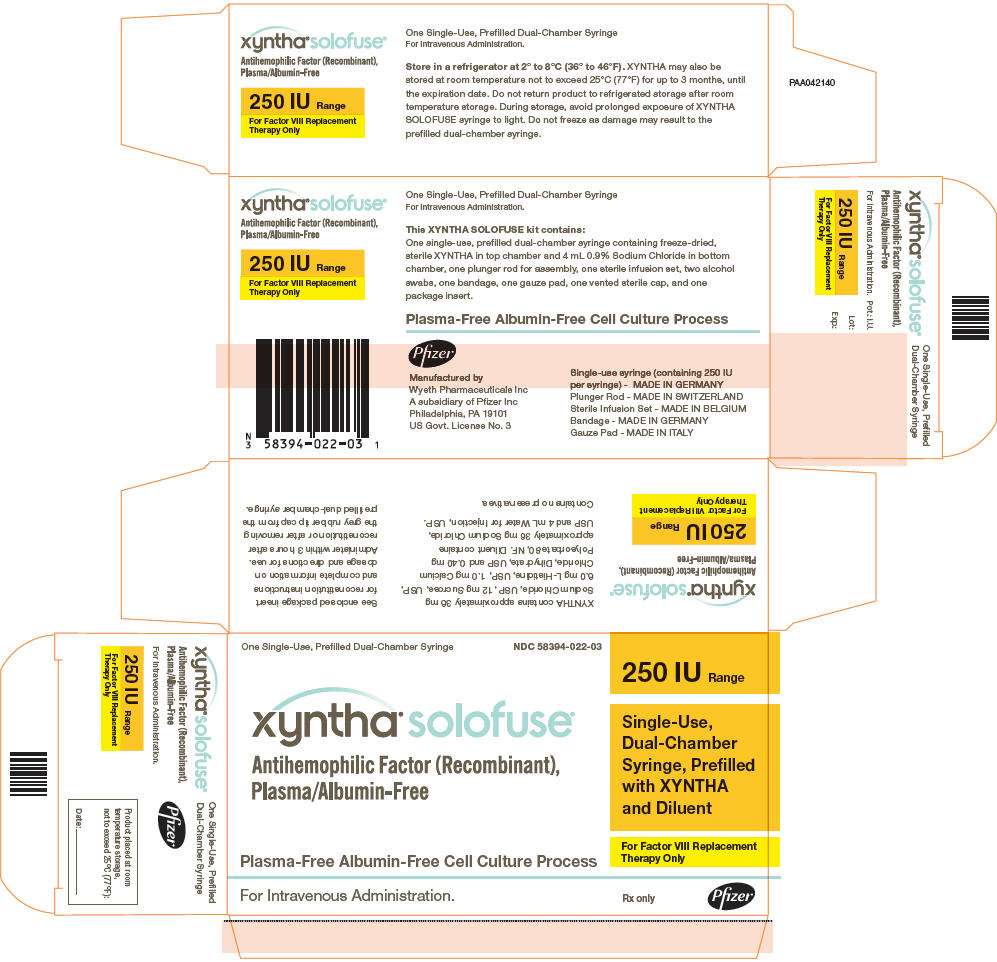
PRINCIPAL DISPLAY PANEL - 500 IU Range Dual-Chamber Syringe Label
NDC 58394-123-03
Xyntha® Solofuse®
Rx only
Antihemophilic Factor
(Recombinant),
Plasma/Albumin-Free
For IV Administration
Dual-Chamber Syringe
No Preservatives. Single Use.
Refrigerate. Protect from light.
Wyeth Pharmaceuticals Inc.
Philadelphia, PA 19101
US Govt. License No. 3
500 IU Range
For Factor VIII Replacement
XYNTHA
SOLOFUSE
Dual-Chamber
Syringe
PAA034213
Lot:
Exp.:
Pot.:
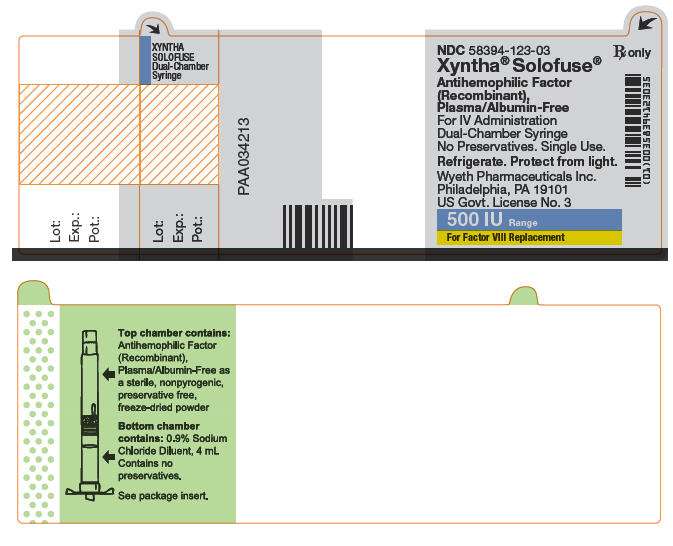
PRINCIPAL DISPLAY PANEL - 500 IU Range Tray Label
xyntha® solofuse®
Antihemophilic Factor (Recombinant),
Plasma/Albumin-Free
500 IU Range
For Factor VIII Replacement
Therapy Only
Manufactured by
Wyeth Pharmaceuticals Inc
A subsidiary of Pfizer Inc
Philadelphia, PA 19101
US Govt. License No. 3
PAA034218
NDC 58394-023-03
Single-Use, Dual-Chamber Syringe, Prefilled with
XYNTHA and Diluent
For Intravenous Administration.
Pfizer
Rx only
Plasma-Free Albumin-Free Cell Culture Process
Store in a refrigerator at 2° to 8°C (36° to 46°F).
XYNTHA may also be stored at room temperature not to exceed
25°C (77°F) for up to 3 months, until the expiration date. Do not
return product to refrigerated storage after room temperature
storage. During storage, avoid prolonged exposure of XYNTHA
SOLOFUSE syringe to light. Do not freeze as damage may result
to the prefilled dual-chamber syringe.
Lot:
Exp.:
Pot.: I.U.
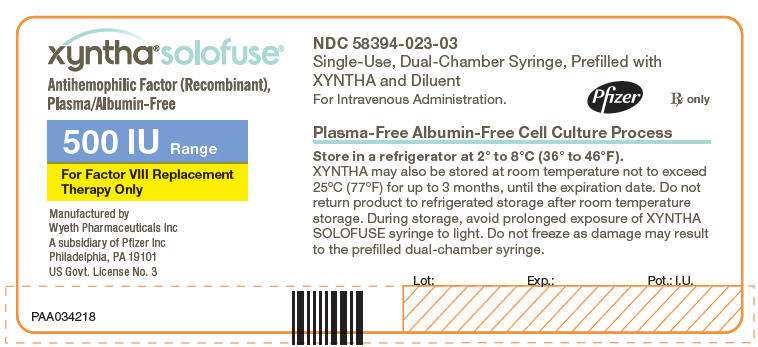
PRINCIPAL DISPLAY PANEL - 500 IU Range Kit Carton
One Single-Use, Prefilled Dual-Chamber Syringe
NDC 58394-023-03
500 IU Range
xyntha® solofuse®
Antihemophilic Factor (Recombinant),
Plasma/Albumin-Free
Single-Use,
Dual-Chamber
Syringe, Prefilled
with XYNTHA
and Diluent
Plasma-Free Albumin-Free Cell Culture Process
For Factor VIII Replacement
Therapy Only
For Intravenous Administration.
Rx only
Pfizer

PRINCIPAL DISPLAY PANEL - 2000 IU Range Dual-Chamber Syringe Label
NDC 58394-125-03
Xyntha® Solofuse®
Rx only
Antihemophilic Factor
(Recombinant),
Plasma/Albumin-Free
For IV Administration
Dual-Chamber Syringe
No Preservatives. Single Use.
Refrigerate. Protect from light.
Wyeth Pharmaceuticals Inc.
Philadelphia, PA 19101
US Govt. License No. 3
2000 IU Range
For Factor VIII Replacement
XYNTHA
SOLOFUSE
Dual-Chamber
Syringe
PAA034215
Lot:
Exp.:
Pot.:

PRINCIPAL DISPLAY PANEL - 2000 IU Range Tray Label
xyntha® solofuse®
Antihemophilic Factor (Recombinant),
Plasma/Albumin-Free
2000 IU Range
For Factor VIII Replacement
Therapy Only
Manufactured by
Wyeth Pharmaceuticals Inc
A subsidiary of Pfizer Inc
Philadelphia, PA 19101
US Govt. License No. 3
PAA034220
NDC 58394-025-03
Single-Use, Dual-Chamber Syringe, Prefilled with
XYNTHA and Diluent
For Intravenous Administration.
Pfizer
Rx only
Plasma-Free Albumin-Free Cell Culture Process
Store in a refrigerator at 2° to 8°C (36° to 46°F).
XYNTHA may also be stored at room temperature not to exceed
25°C (77°F) for up to 3 months, until the expiration date. Do not
return product to refrigerated storage after room temperature
storage. During storage, avoid prolonged exposure of XYNTHA
SOLOFUSE syringe to light. Do not freeze as damage may result
to the prefilled dual-chamber syringe.
Lot:
Exp.:
Pot.: I.U.
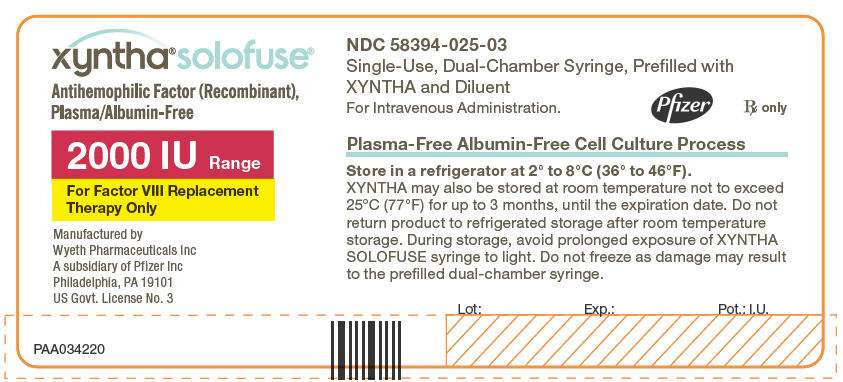
PRINCIPAL DISPLAY PANEL - 2000 IU Range Kit Carton
One Single-Use, Prefilled Dual-Chamber Syringe
NDC 58394-025-03
2000 IU Range
xyntha® solofuse®
Antihemophilic Factor (Recombinant),
Plasma/Albumin-Free
Single-Use,
Dual-Chamber
Syringe, Prefilled
with XYNTHA
and Diluent
Plasma-Free Albumin-Free Cell Culture Process
For Factor VIII Replacement
Therapy Only
For Intravenous Administration.
Rx only
Pfizer
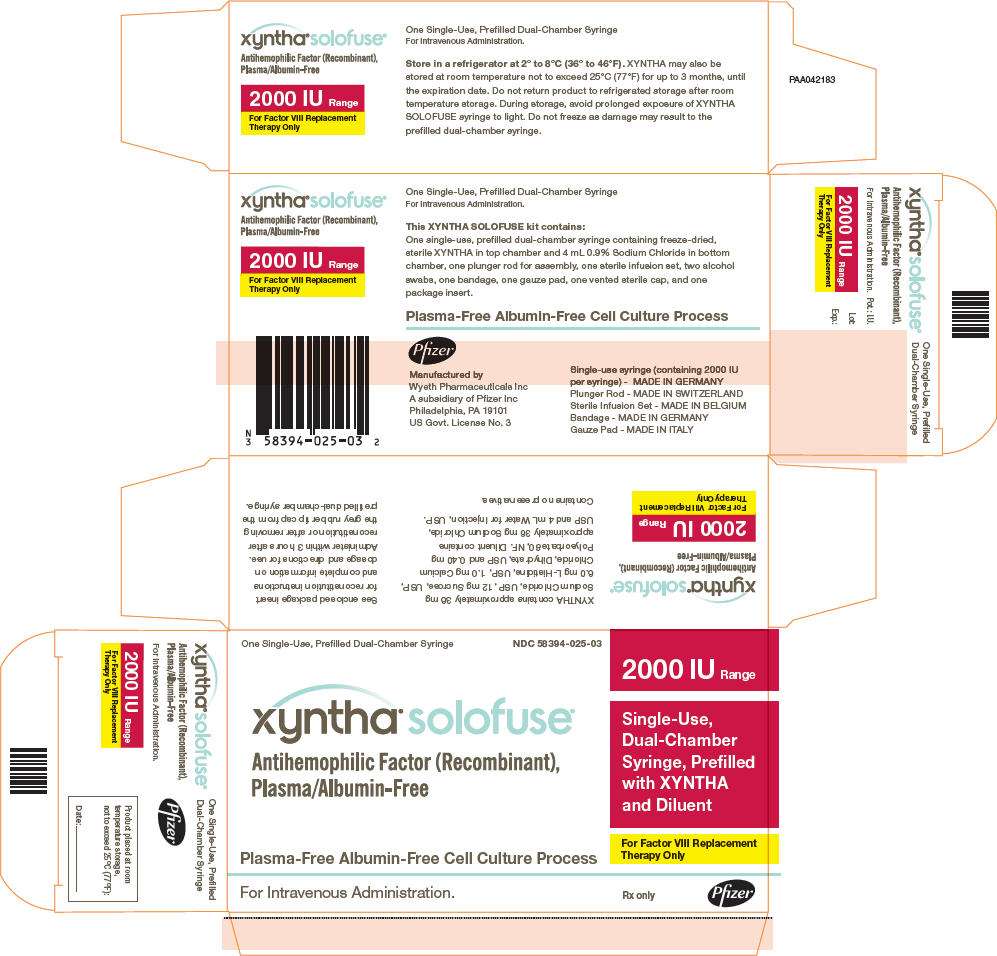
PRINCIPAL DISPLAY PANEL - 3000 IU Range Dual-Chamber Syringe Label
NDC 58394-116-03
Xyntha® Solofuse®
Rx only
Antihemophilic Factor
(Recombinant),
Plasma/Albumin-Free
For IV Administration
Dual-Chamber Syringe
No Preservatives. Single Use.
Refrigerate. Protect from light.
Wyeth Pharmaceuticals Inc.
Philadelphia, PA 19101
US Govt. License No. 3
3000 IU Range
For Factor VIII Replacement
XYNTHA
SOLOFUSE
Dual-Chamber
Syringe
PAA034216
Lot:
Exp.:
Pot.:
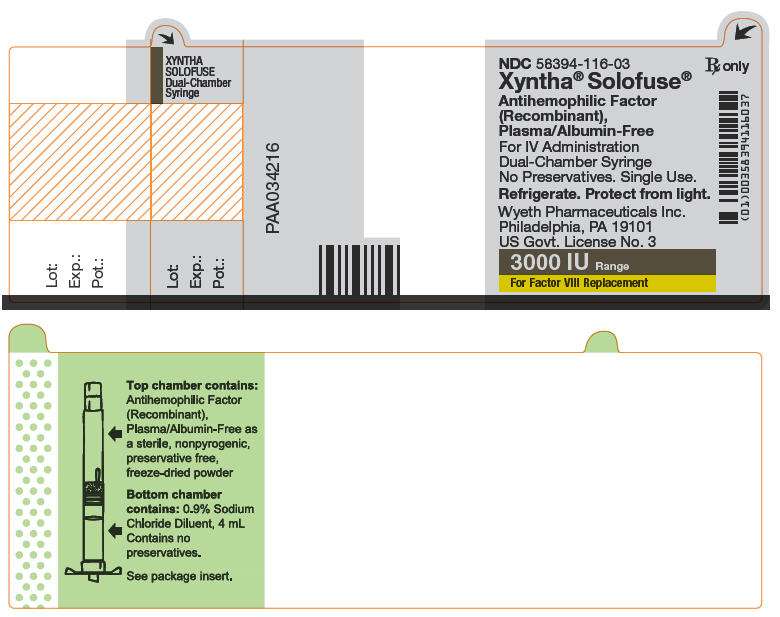
PRINCIPAL DISPLAY PANEL - 3000 IU Range Tray Label
xyntha® solofuse®
Antihemophilic Factor (Recombinant),
Plasma/Albumin-Free
3000 IU Range
For Factor VIII Replacement
Therapy Only
Manufactured by
Wyeth Pharmaceuticals Inc
A subsidiary of Pfizer Inc
Philadelphia, PA 19101
US Govt. License No. 3
PAA034221
NDC 58394-016-03
Single-Use, Dual-Chamber Syringe, Prefilled with
XYNTHA and Diluent
For Intravenous Administration.
Pfizer
Rx only
Plasma-Free Albumin-Free Cell Culture Process
Store in a refrigerator at 2° to 8°C (36° to 46°F).
XYNTHA may also be stored at room temperature not to exceed
25°C (77°F) for up to 3 months, until the expiration date. Do not
return product to refrigerated storage after room temperature
storage. During storage, avoid prolonged exposure of XYNTHA
SOLOFUSE syringe to light. Do not freeze as damage may result
to the prefilled dual-chamber syringe.
Lot:
Exp.:
Pot.: I.U.

PRINCIPAL DISPLAY PANEL - 3000 IU Range Kit Carton
One Single-Use, Prefilled Dual-Chamber Syringe
NDC 58394-016-03
3000 IU Range
xyntha® solofuse®
Antihemophilic Factor (Recombinant),
Plasma/Albumin-Free
Single-Use,
Dual-Chamber
Syringe, Prefilled
with XYNTHA
and Diluent
Plasma-Free Albumin-Free Cell Culture Process
For Factor VIII Replacement
Therapy Only
For Intravenous Administration.
Rx only
Pfizer

Xynthaantihemophilic factor (Recombinant, Plasma/Albumin-Free) KIT
| ||||||||||||||||||||||||||||||||||||||||
Xynthaantihemophilic factor (Recombinant, Plasma/Albumin-Free) KIT
| ||||||||||||||||||||||||||||||||||||||||
Xynthaantihemophilic factor (Recombinant, Plasma/Albumin-Free) KIT
| ||||||||||||||||||||||||||||||||||||||||
Xynthaantihemophilic factor (Recombinant, Plasma/Albumin-Free) KIT
| ||||||||||||||||||||||||||||||||||||||||
Xynthaantihemophilic factor (Recombinant, Plasma/Albumin-Free) KIT
| ||||||||||||||||||||||||||||||||||||||||